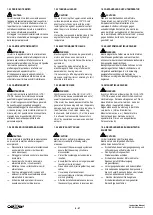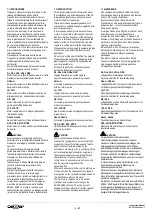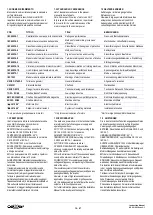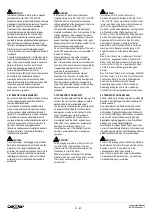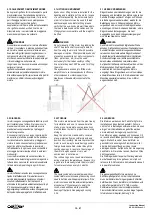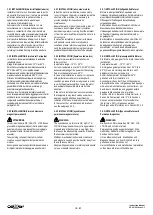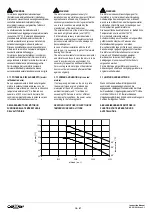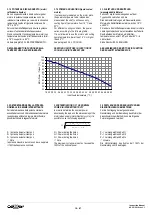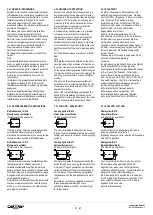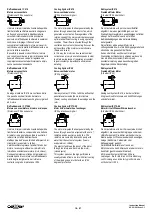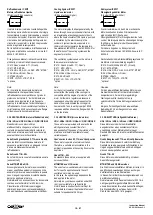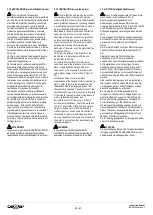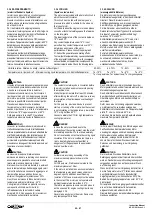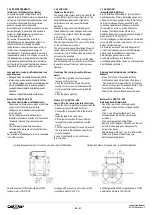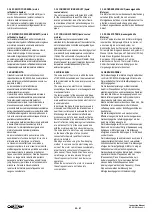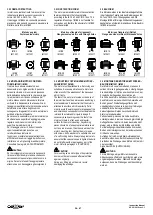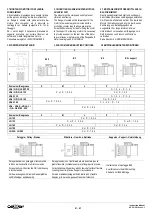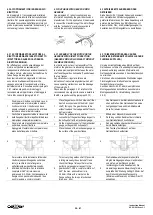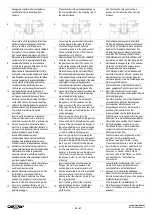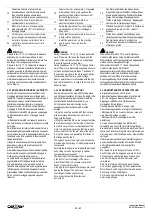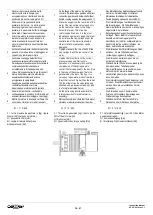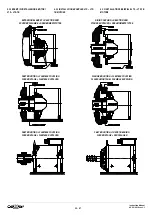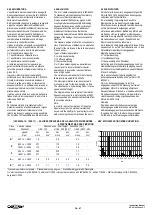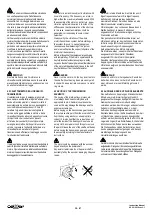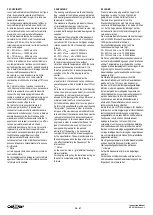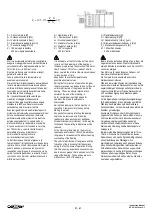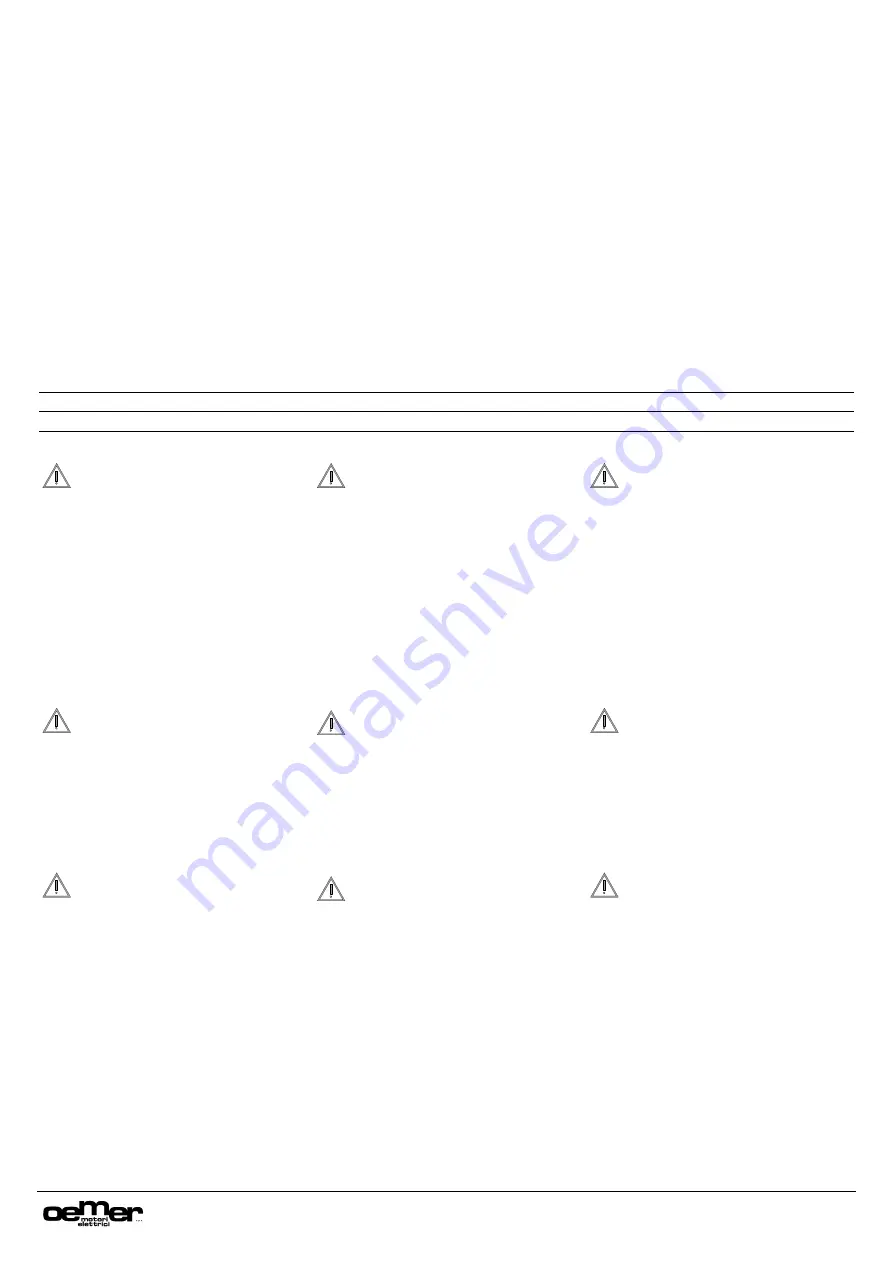
22 - 97
Instruction Manual
AC 02/2019-rev.1.1
3.3.4 RAFFREDDAMENTO
(motori raffreddati a liquido)
I motori sono provvisti di un circuito stagno nel
quale circola il liquido di raffreddamento.
Questo circuito deve essere alimentato con una
portata ed una pressione idonea alla grandezza
ed al tipo di motore.
Per i dati relativi alle singole grandezze
consultare il catalogo tecnico ed i dati di targa. La
temperatura ideale del liquido di raffreddamento
è compresa tra 18°C ed i 22°C.
Temperature del liquido inferiori a 16°C non sono
ammesse. Temperature del liquido superiori a 20°C
determinano una diminuzione delle prestazioni del
motore. Consultare il paragrafo 3.1.2 potenza e
riscaldamento.
Temperature del liquido di raffreddamento troppo
basse possono causare la condensazione dell’aria
presente all’interno del motore con conseguenti gravi
danni per l’isolamento elett
rico e le parti meccaniche
interne. Consulatare la tabella successiva.
3.3.4 COOLING
(liquid cooled motors)
The motors are provided with a hermetic circuit in
which the coolant circulates.
This circuit must be fed with a delivery and a
pressure rate which is suitable for the size and
the type of motor.
For the data about the single motor sizes please
consult our technical catalogue and the features
on the rate-plate.
The ideal temperature of the coolant is between
18°C and 22°C.
Any coolant temperature under 16°C is not
permitted. Any coolant temperature over 20°C
determines a decrease of the motor
performances. Please consult the paragraph
3.1.2about the power rates and heating effects.
Too low liquid temperarute may cause condensation
of the air present inside the motor with consequent
serious troubles on the electrical insulation and the
mechanical parts inside. Check the following table.
3.3.4 KÜHLUNG
(wassergekühlte Motoren)
Die Motoren sind mit einem geschlossenen
Kühlkreislauf ausgerüstet, in dem das Kühlmittel
zirkuliert. Dieser Kreislauf muss mit
Kühlflüssigkeitsmenge und -druck entsprechend
dem Motortyp und -grösse gespiesen werden.
Für die Daten der einzelnen Motore bitte im
Datenblatt oder auf dem Typenschild nachsehen.
Die ideale Temperatur des Kühlmittels liegt
zwischen 18°C und 22°C.
Kühlmitteltemperaturen unter 16°C sind nicht
erlaubt. Kühlmitteltemperaturen über 20°C
bedingen eine Reduzierung der Leistungsdaten des
Motors, siehe Abschnitt 3.1.2 über Leistungsdaten
unter Temperatureinfluss.
Zu tiefe Kühlmitteltemperaturen können
Kondensationen im Motorinneren hervorrufen, die
zu schwere Schäden an der Isolation und den
mechnaischen Bauteilen führen. Siehe
untenbestehende Tabelle.
Umidità relativa -
Relative humidity -
relative Luftfeuchtigkeit
40...50%
60...70%
70...80%
90%
Temperatura min. liquido di raff. -
Minimum cooling liquid temperature-
min. Kühlmitteltemperatur
Ta
–
15°C
Ta
–
10°C
Ta
–
8°C
Ta
–
5°C
Ta = temp. ambiente, Ta = ambient temp., Ta = Umgebungstemp.
CAUTELA
Il liquido refrigerante deve sempre essere messo
in circolazione prima
dell’avviamento
del motore
e non deve mai essere fermato durante il
funzionamento della macchina. Far circolare il
liquido per almeno 20 min. dopo lo spegnimento
del motore per evitare l’accu
mulo di temperatura
interno e la possibilità di ebollizione del liquido.
Prevedere un dispositivo che impedisca
l’avviamento e/o il funzionamento del motore
quando il liquido non è in circolo o la temperatura
è inferiore ai 16°C oppure superiore ai 60°C.
Collegare sempre la sonda PTO per allame
temperatura massima liquido raffreddamento.
PERICOLO
In caso di surriscaldamento del motore dovuto al
malfunzionamento del circuito di raffreddamento
fermare immediatamente il motore ed attendere che
si raffreddi naturalmente. Non ripristinare e non far
circolare il liquido di raffreddamento se il motore è
surriscaldato, si potrebbe creare vapore ad altra
pressione con conseguenti fuoriuscita e pericolo per
le persone e le cose circostanti.
CAUTELA
La massima pressione di alimentazione
ammessa ed indicata sul catalogo non deve mai
essere superata, prevedere un valvola di sfiato
tarata alla pressione massima di 3 bar.
Nel caso in cui il motore sia installato in ambienti
dove la temperatura potrebbe raggiungere valori
al di sotto dello zero è necessario aggiungere al
liquido refrigerante un additivo idoneo per
evitarne il congelamento (soluzione al 35%
max).
Non è ammesso l’utilizzo del motore con
temperatura ambiente inferiore a -20°C.
Consigliamo di utilizzare un prodotto comune
come quello utilizzato per il circuito di
raffreddamento delle automobili, vedere
paragrafo 3.3.5. Non eseguire fori o lavorazioni
meccaniche sulla struttura del motore.
CAUTION
The coolant must always be in circulation before
the motor is started and must never stop during
the machine’s run.
Make the liquid circulate for at least 20 minutes
after switching the motor off in order to avoid any
accumulation of heat inside and overheating of
the liquid.
For this purpose, provide a device to prevent
start-up or running of the motor when the coolant
is not circulating or the temperature is lower than
16°C or higher than 60°C..
Connecto alwais the PTO for high temperature
cooling liquid alarm.
DANGER
In case the motor overheats due to the
malfunction of the cooling system, stop the motor
immediately and allow it to cool down naturally.
Do not reset and do not activate the cooling liquid
circulation if the motor is overheated, there is a
risk to create high-pressure steam that is
dangerous for the people and the equipment
located near the motor.
CAUTION
Furthermore, avoid any exceeding of the
maximum delivery pressure shown in the
catalogue.
For this purpose, fit a bleed valve rated to the
maximum pressure of 3 bar.
If the motor is installed in an environment where
the temperature may reach values under zero
degrees, specific additives as antifreezing
(solution of 35% as a maximum) must be added
to the coolant. The motor can not operate with
ambient temperatures lower than -20°C.
Therefore we propose to use a common product
as the one used for engine cooling circuits, see
paragraph 3.3.5..
Never make any holes in the motor frame or do
any tampering with its frame.
ACHTUNG
Das Kühlmittel muss immer zirkulieren bevor der
Motor gestartet wird und darf niemals während des
Motorsbetriebs gestoppt werden.
Das Kühlmittel muss mindestens 20 Minuten nach
dem Abschalten des Motors nachzirkulieren, um
Überhitzung des Motors und des Kühlmittels zu
vermeiden.
Dafür muss eine Vorrichtung vorgesehen werden,
um Motoranlauf zu vermeiden solange das
Kühlmittel nicht zirkuliert oder die Temperatur tiefer
als 16°C oder zu höher als 60°C ist.
Verbinden Sie die Sonde an die Zapfwelle allame
maximale Temperatur Kühlmittel.
GEFAHR
Im Falle einer Überhitzung des Motors wegen einer
Fehlfunktion des Kühlkreislaufes den Motor
unverzüglich stoppen und die Abkühlung abwarten.
Nicht wieder starten und den Kühlkreisaluf
aktivieren, solange der Motor überhitzt ist. Es
könnte Dampf mit hohem Druck austreten, der
Personen und Ausrüstung in der Umgebung
gefährdet.
ACHTUNG
Der maximale Druck des Kühlmittels, der im
Katalog angegeben ist, darf niemals überschritten
werden. Deshalb muss ein Druckbegrenzungventil
vorgesehen werden, das auf den maximal Druck
auf 3 bar begrenzt.
Wenn der Motor in einer Umgebung installiert ist, in
der die Temperatur unter 0°C fallen kann, müssen
dem Kühlmittel spezifische Fostschutzmittel
beigefügt werden (max. Konzentration 35%). Der
Betrieb bei Umgebungtemperaturen unter -20°C ist
nicht erlaubt.
Wir empfehlen dafür ein gängiges Frostschutzmittel,
wie es für den Kühlkreislauf in Automobilen
eingesetzt wird, siehe Abschnitt 3.3.5.
Niemals Bohrungen oder andere Bearbeitungen am
Gehäuse ausführen.

